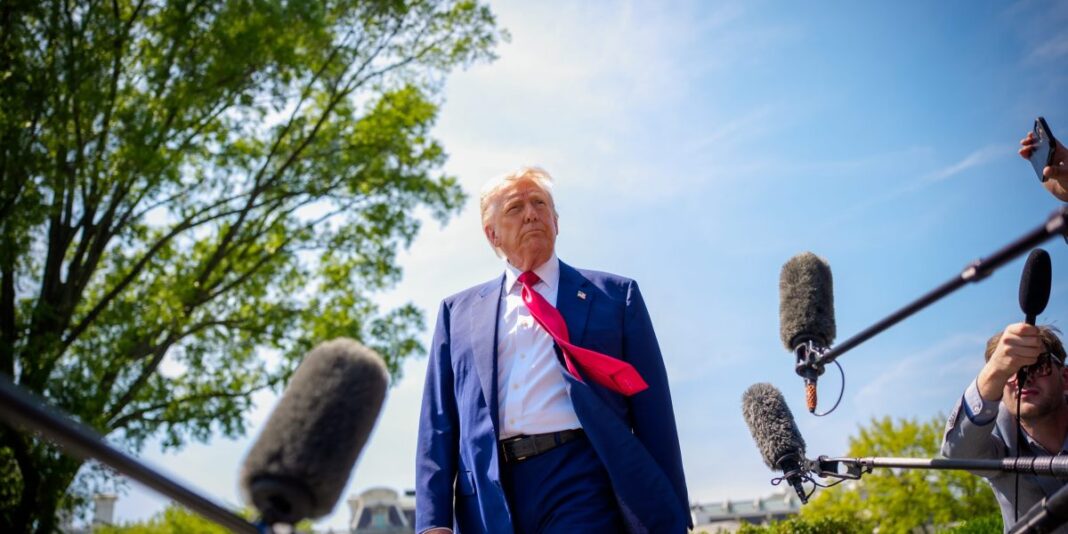- Consumer confidence in the U.S. has fallen sharply amid rising concerns over tariffs and economic instability, with The Conference Board reporting its lowest expectations index since 2011. Despite this, President Trump maintains that voters endorsed his tough trade stance during the election, even as polls showed many backed him for promises of economic improvement and lower inflation.
American consumers are growing increasingly uncomfortable with the economic outlook as the White House continues its robust tariff rhetoric with no deals yet agreed with trading partners.
Yet President Trump said this unease is what the American people signed up for when they voted him into the Oval Office.
This view is seemingly at odds with the polls shared ahead of the election, which showed voters backed the Republican candidate because they believed he would better manage the economy.
However, after 100 days since the second Trump administration, families have begun to question the path the White House is taking.
According to The Conference Board, consumers’ confidence hasn’t been this low since 2020, at the height of the pandemic.
In a release yesterday, the board shared that the public’s economic confidence was down 7.9 points in April to an index reading of 86.
Meanwhile, the expectations index—based on consumers’ short-term outlook for income, business, and labor market conditions—dropped 12.5 points to 54.4, the lowest level since October 2011. It is also well below the threshold of 80, which usually signals a recession ahead.
Stephanie Guichard, senior economist, global indicators at The Conference Board, said in the release: “The decline was largely driven by consumers’ expectations.
“The three expectation components—business conditions, employment prospects, and future income—all deteriorated sharply, reflecting pervasive pessimism about the future.”
The survey, which takes an online sample from more than 36 million consumers, added tariffs are the number one concern for consumers with mentions reaching an “all time high” in written responses.
Trump: Voters signed up for this
Yet President Trump argues that voters knew what they were getting into when they elected him to the Oval Office.
“[Voters] did sign up for it actually,” the president told ABC in an interview released yesterday. “This is what I campaigned on. I said that we’ve been abused by other countries at levels that nobody’s ever seen before … they were taking advantage of us. I could have left it that way and at some point there would have been an implosion like nobody’s ever seen.
“But I said, ‘No, we have to fix it.’ I’ve wanted to do this for many years.”
When it was pointed out to Trump that he also ran on a promise of lowering prices and restoring economic stability, Trump retorted that he has, and will continue to, bring inflation down despite the consensus among economists that this strategy will raise prices.
When questioned if hard times were ahead he disagreed, saying: “I don’t think so, I think great times are ahead. Since I came in gasoline is down, groceries are down, egg prices are down, many things are down … when toy have that kind of a drop, you’re not going to have inflation.”
Is this what America voted for?
Both before and since the election, voters said one of their major motivators for backing Trump was that they believed he would do a better job on the economy.
A Navigator survey of more than 5,000 voters in November, for example, found that the joint-top reason people backed the Republican candidate was that he would bring down inflation and improve the state of the national economy.
Likewise, in the weeks before the election, a New York Times and Siena College poll found 52% of people trusted Trump to lead the economy over Harris, who scored 45%.
A Financial Times and University of Michigan’s Ross School of Business survey reported 44% of voters believed Trump would do a better job with the economy, compared to 43% who said Harris.
So while Trump was clear on the campaign trail that he wanted to rebalance America’s trade deals, voters perhaps didn’t join the dots on the economic instability they may have to suffer.
Markets have already had the same reckoning, after volatility began to rise as tariff news increased.
As JPMorgan Private Bank’s U.S. head of investment strategy, Jake Manoukian, told Fortune in an exclusive interview last month: “So far … Trump is almost the opposite of what the expectations were in November, December, January. That came at a time when the S&P500 was trading at 22 times forward P/E multiple, baking in a lot of enthusiasm around an acceleration in corporate earnings and a re-engagement of capital market activity.
“It’s the confluence of the disconnect between the expectations and reality that needs to be realigned, and that’s manifesting itself through a selloff in the S&P 500 that’s been concentrated in some of the most popular, highly valued names.”
This story was originally featured on Fortune.com
Source link

